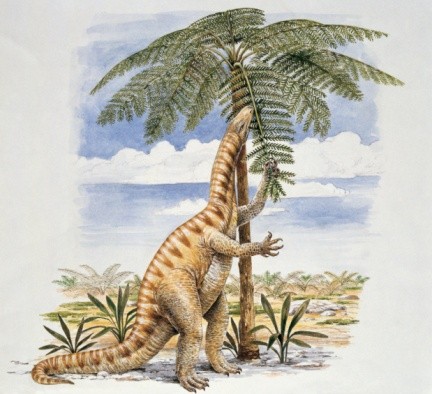2 Dinosaur Fossils Unearthed in Yunnan, China
| Cybelle Go | | Dec 09, 2015 06:04 AM EST |
(Photo : Getty Images) Both of the dinosaurs are said to have long necks and ate plants for nutrition.
Two dinosaur vestiges from the Jurassic Period have been discovered in the Yunnan Province, China in November, according to Xinhua.
The two fossils were uncovered during the construction of a road in Yufeng County, Chuxiongyi Autonomous Province, Yunnan. The fossils have been identified as that of a Lufengosaurus Magnus and Lufengosaurus Huenei by the Institute of Vertebrae Paleontology.
Like Us on Facebook
These dinosaurs were deemed to have roamed the planet approximately 180 million years ago.
Wang Tao, the director of Department of Geological Heritage Protection, explained the characteristics of Lufengosaurus Magnus, which has complete hind legs, backbones that comprise 38 vertebrae and a height estimated to be more than nine meters long (30 feet).
The Lufengosaurus Huenei was found 500 meters away from the other fossil. The discovered structure of the fossil consists of two preserved shanks and five backbone vertebrae.
Both of the dinosaurs are said to have long necks and ate plants for nutrition.
These species were first discovered in the same province by Yang Zhongjian, a Chinese paleontologist in 1938. Zhongjian was accompanied by geologist Bien Meinan.
Lufengosaurus Huenei was the first species discovered by Yang. Lufengosaurus was derived from the Lufeng, the dinosaurs' place of discovery.
Huenei was chosen as the specific name of the dinosaur in honor of Friedrich Von Huene, a German paleontologist and Yang's former mentor.
In 1958, Lufengosaurus was declared to be the first complete skeleton mounted in China, according to GB Times.
In 2013, the Lufengosaurus' embryo, or the structure of the living animal prior to hatching, was also discovered in the Yunnan province of China.
A team also unearthed more than 200 bones, revealed to be from the dinosaur's different stages of development inside the egg.
"We will continue in situ conservation once we have built a museum at the excavation site," said Wang, in an interview with Xinhua.
Tagslufengosaurus, Fossils, Unearthed, Yunnan, Lufengosaurus Magnus, Lufengosaurus Huenei, 180-year-old dinosaur fossil China
©2015 Chinatopix All rights reserved. Do not reproduce without permission
EDITOR'S PICKS
-

Did the Trump administration just announce plans for a trade war with ‘hostile’ China and Russia?
-

US Senate passes Taiwan travel bill slammed by China
-

As Yan Sihong’s family grieves, here are other Chinese students who went missing abroad. Some have never been found
-

Beijing blasts Western critics who ‘smear China’ with the term sharp power
-

China Envoy Seeks to Defuse Tensions With U.S. as a Trade War Brews
-

Singapore's Deputy PM Provides Bitcoin Vote of Confidence Amid China's Blanket Bans
-

China warns investors over risks in overseas virtual currency trading
-

Chinese government most trustworthy: survey
-

Kashima Antlers On Course For Back-To-Back Titles
MOST POPULAR
LATEST NEWS
Zhou Yongkang: China's Former Security Chief Sentenced to Life in Prison

China's former Chief of the Ministry of Public Security, Zhou Yongkang, has been given a life sentence after he was found guilty of abusing his office, bribery and deliberately ... Full Article
TRENDING STORY

China Pork Prices Expected to Stabilize As The Supplies Recover

Elephone P9000 Smartphone is now on Sale on Amazon India

There's a Big Chance Cliffhangers Won't Still Be Resolved When Grey's Anatomy Season 13 Returns

Supreme Court Ruled on Samsung vs Apple Dispute for Patent Infringement

Microsoft Surface Pro 5 Rumors and Release Date: What is the Latest?












